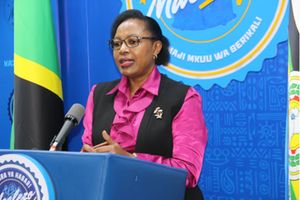How early disease detection tech will bolster maize yields

A set of IoT embedded devices put together with volatile organic compounds sensors and ultrasound movement sensors placed next to a maize plant for collecting non-visual parametres for maize disease detection. PHOTO | COURTESY
What you need to know:
- The researchers will develop a ChatGPT-powered Swahili chatbot that will detect diseases in maize farms that can’t be detected visually
Dar es Salaam. A Sokoine University of Agriculture (Sua) researcher, Ms Theofrida Maginga and a colleague from the African Centre of Excellence on Internet of Things (IoT) at the University of Rwanda, Dr Jimmy Nsenga, have secured $100,000 (Sh245 million) in funding from the Bill and Melinda Gates Foundation.
The funds secured as part of the Grand Global Challenge will enable the researchers to design technology that will enable smallholder farmers with limited literacy and scarce resources to quickly and easily detect crop diseases such as Northern Leaf Blight.
The researchers will use the funds to develop a Chat Generative Pre-trained Transformer (ChatGPT)-powered Swahili chatbot that will detect diseases in maize farms that can’t be detected visually, leading to losses in yields and income.
Reports show that 40 percent of maize yield in East Africa is lost, threatening the realisation of targets to ensure food security and zero hunger amidst a drastic increase in the world population.
The researchers will also integrate artificial intelligence (AI) with Internet of Things (IoT) technologies and use non-invasive sensors to monitor non-visual early disease indicators.
These include volatile organic compounds (VOCs), ultrasound movements, and the uptake of soil nutrients.
The duo will also develop and integrate a Swahili chatbot to interact with farmers in their local languages in a culturally-sensitive manner and perform model validation and field testing.
The Sua assistant lecturer currently pursuing a PhD in Internet of Things with specialisation in Embedded Computing Systems at the University of Rwanda’s African Centre of Excellence, told The Citizen that the visual symptoms are impacts of late detection of disease, which has already progressed to advanced cycles.
Ms Maginga said advanced disease cycles include different phases such as inoculation, penetration, infection, incubation, reproduction, and survival, therefore requiring higher intervention measures in order to control the diseases.
“We are developing sensors that will be placed next to plants with disease and those without disease. In the laboratory tests, when a disease was introduced to certain parts of the crop, some differences were noted over time,” she said.
“Research to establish the difference when IoT sensors are used was carried out; specifically, the sensors were used for checking the emission of gases and stem movement in a plant,” she added.
According to the researcher, the nonvisual signs incorporated in the maize crop include volatile organic compounds (VOC), ultrasound, nitrogen, phosphorus and potassium (NPK) uptake.
She explained that the NPK sensors were used to monitor the intake of nutrients by both the diseased and unaffected maize crops.
“The main goal was to come up with a simple device that uses low power and that requires less interaction with individual farmers, but that can still be placed in the field, and farmers can be told what is going on in the field,” she added.
According to the lecturer, poor gas emissions are a sign that the crop may be infected with a disease.
According to her, what made funders chip in was the fact that technology can be integrated with chatbots, where answers could be provided to questions raised by farmers.
“It means chatbots can be asked simple questions and provide room for the generation of appropriate answers. Therefore, we are working to bring ChatGPT in terms of chatbots to farmers,” she said.
“We have the IoT part, but instead of forcing farmers to report to extension officers after detecting diseases, the technology will do that, minimising interaction with human beings,” she added.
Ms Maginga said with the funding, they are currently generating as many questions and answers as possible that originate from farmers themselves.
The questions and answers will be stored in a database and will be reproduced in terms of questions and answers as if farmers were communicating with extension officers.
The chatGPT model willfacilitate the formulation of a question-answer format before being communicated to farmers.
“The question-answer communication will initially be done through WhatsApp because we don’t want farmers to start downloading the new application. They simply need to have connected mobile phones,” she said.

Sokoine University of Agriculture assistant lecturer Theofrida Maginga sets up the devices ready for capturing the data for maize crops at one of the greenhouses at Sua during their first trial experiment. PHOTO | COURTESY
The technology will involve testing to establish ways to reach the majority of smallholder farmers in remote areas.
Ms Maginga said most farmers make late detections of disease outbreaks in their maize farms, triggering huge losses.
“In this sense, diseases keep spreading to other field areas, broadening the loss to almost half of farmers’ expectations. The impact is passed on to seeds, therefore giving poor results when grown in the future,” she said.
“The disease becomes progressive and farmers are left with affected maize, therefore denying them competitive market prices both domestically and internationally,” she said.
Ms Maginga said one of the biggest privileges during the processing of the grant from the Bill and Melinda Gates Foundation was Sua’s focus on agriculture.
Also, the kind of agriculture that the institution practices was an added advantage.
“It was easy to apply as a team or an individual member of the institution, to prove the concept at hand and finally deliver solutions to farmers,” she said.
Being affiliated with an institution specializing in agriculture, it was impressive that two people with different expertise collaborated to come up with a solution for farmers.
According to Ms Maginga, the technology will be deployed to farmers not later than December 2023, after the testing is concluded in mid November.
Before the full deployment, a number of trainings will be conducted for farmers and extension officers on the best way to interact with the technology, which will be known as MKULIMAGPT.
“AI and IoT-performing devices will be in the field around next year because we are looking for collaboration with the Seoul National University of South Korea, which can also provide expertise in perfecting the IoT technology and devices,” she said.
She said they are still testing the system in order to calibrate and bring accurate results, including models that are trained and developed.
“This will be repeatedly done to ensure we have well-performing models. The technology will be made available to farmers free of charge provided they download WhatsApp on their mobile phones.”
The researchers are currently working with farmers in Morogoro Region. The technology will later be made available to maize farmers in the Southern Highlands regions, including Mbeya, Rukwa, Katavi, Iringa, and any other interested regions.
She called for more women to join the engineering field, saying that involvement in science and technology carries numerous and attractive opportunities.
“This is an area with enough funding opportunities, provided there are well-designed concepts. So, more women and girls should engage in science and technology in order to provide more solutions to problems affecting society,” she advised.
She said Tanzania has huge potential to become the biggest food producer on the continent and in the world at large.
“This is because the country has a lot of resources that include enough arable land and conducive climatic conditions that allow production of different crops,” she said.




